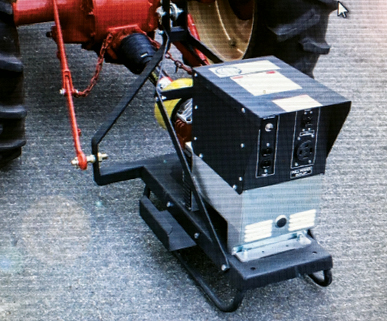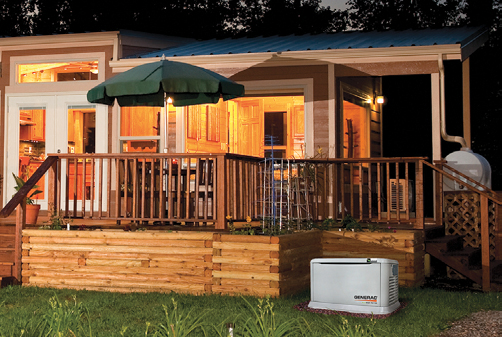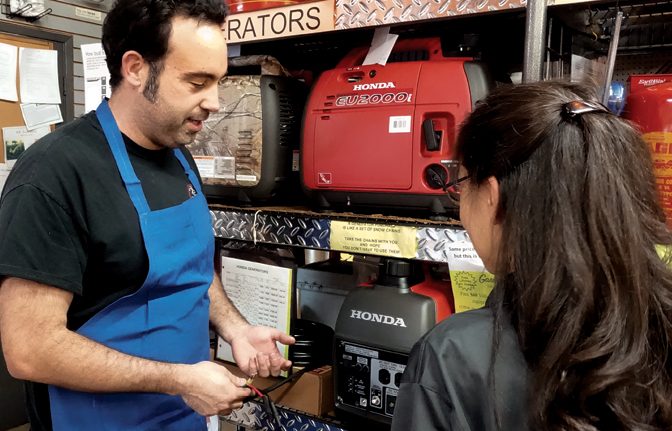Pictured Above: Chris Daleen of Gardenland Power Equipment, Campbell, Calif., helps a customer choose a generator for camping applications.
There’s likely not a product in the arsenal of a rural lifestyle dealer that would more characterize the definition of “feast or famine” than generators.
The “feast” occurs when a large area is suddenly out of power due to a natural disaster, such as an ice storm, hurricane or high winds. Then, all available generators sell, with customers so appreciative to have the product to save their freezer full of meat or to restore power to their house, they idolize the dealer who provided it.
Dealers may not hear from that customer again until the next weather event, a decade or so later, when the old, dusty generator comes out of the machine shed with the original equipment fuel and it won’t start. There’s probably a little less affection felt for the selling dealer at that point.
The challenge for generator sales is in the “famine” period, which is generally most of the time, unless dealers specialize in finding unique ways to market the product by uncovering new and growing niche markets and by selling annual service packages.
To better understand the generator market, it’s important to know that they can be powered two ways. PTO generators rely on a tractor for power and are less complex. They offer more kilowatts for the dollar and avoid the problems associated with old fuel, which is common in other types of generators. Stand-alone generators have an internal engine and can be powered by gas, natural gas, propane or diesel.
All generators are measured by the kilowatts of power they supply. The smallest generators are used mostly for recreation; mid-range units can be used for construction and other industrial applications; and larger units provide standby power for rural homes and livestock operations and backup power for off-the-grid cabins.

Tractor owners can get more power for the money and avoid old fuel issues by investing in PTO generators.
PHOTO COURTESY OF SSB Tractor
Selling Online
Christopher Daurio of SSB Tractor, Long Island, N.Y., specializes in sales of tractor parts, owner’s manuals, front-end loaders, implements and PTO generators. The dealership carries parts for Massey Ferguson, John Deere, New Holland, Zetor and other lines. The dealership sells 50-60 generators annually to customers in the lower 48 states, with 90% coming through online sales.
Daurio outlines the secret of their success. “To get that kind of volume, you have to make sure that you beat the price of the competitors and have a quality product to stand behind. We include shipping on Amazon and have a low rate with our FedEx supplier.
“On the generators we sell, pretty much all the framing and the PTO gearbox is made in the U.S. and the generator components are made in Italy, one of their top-notch brands.
“We offer a range from 10 kilowatts up to about 50 kilowatts. We won’t sell a complete kit that customers can install, because, technically, they’re not allowed to put it in their house; they need a licensed electrician. But we do sell the transfer boxes and the plug that goes to the generator, so it’s possible to get power to the house without running a bunch of extension cords.
Dealer Takeaways
• Selling generators may not be a huge “moneymaker” for the average rural lifestyle dealer, but they’re an item, like compact tractors, that those who are moving to rural areas may have on their shopping lists.
• Providing the service to back them up and a supply ready for widespread power outages may bring huge spikes in generator sales during weather events. Providing annual service contracts may increase downstream revenue from sales.
• Rural lifestylers living in off-the-grid cabins and owners of food truck businesses may offer a growing customer base and may eventually be prospects for other equipment.
• You may be able to increase sales by bundling a PTO generator into the payment for a compact tractor, showing the customer that their monthly payment will only increase by a small amount.
“The average customer is finding a local electrician and when he shows up, they say ‘Here’s this stuff, make it work.’ It cuts down on the cost for them as everything they need is supplied,” Daurio says.
Showing the actual product in action through marketing on the website attracts a lot of customers. “Pictures and videos grab people and we have both on our website, www.SSBtractor.com. You want real pictures of the product to show that you have them at the dealership, not highly produced photos from the manufacturer. You can also see a video of the generator running off a Ford 8N tractor that’s only 19 horsepower, but still putting out a bunch of electricity, at least enough to run a fridge and some household items,” Daurio says.
Selling on the Internet provides some challenges when there’s a service issue.
“What we do is offer full replacement right off the bat. We will set up and pay for return pickup and arrange for another shipment to go directly to the customer. Or if it’s something small, my supplier will give me a rundown of repair tips and send the part for free. Also, my supplier has a list of shops throughout the U.S. that are authorized to do warranty service — we just need the receipt from a recommended shop to cover the repair,” Daurio says.
Specializing in Generators
Rural lifestyle dealers who want to enter the generator market will not only face online competition, but will also be competing with local electricians and supply companies like Echo Group Inc., which has locations in Iowa, Nebraska, Minnesota and South Dakota and services portions of Missouri and Kansas.
Jeremy Engelman is vice president of operations for Echo Group, which sells direct to consumers and also distributes to dealers. They sell both PTO and stand-alone generators. Brands include Honda, Yamaha, Kubota, Winco, Generac and Siemens.
Echo Group retails between 400-500 units each year, starting off with the 1 kilowatt models, which are typically used for telecommunications, tailgating, camping or trade show booths. Residential automatic standby units start at 6 kilowatts and go up to 22 kilowatts with the air-cooled engine line. Liquid-cooled products range from 20 kilowatts to about 150 kilowatts, powered by propane or natural gas. Topping out the line are industrial diesel-powered units.
About 10-15% of the company’s generator sales are for PTO units, but Engelman says that number has been gradually dropping.
“The PTO units are still sellers, but with an aging population, in the last decade we’ve seen a number of customers not as physically able to get the tractor out and make the connections with a PTO. Therefore, they’re more likely to consider automatic standby generators. Some of what’s driving that is the costs have come down considerably and quality has improved on those automatic standby units in the last 15 years or so.”
“We take them through a needs chart to determine exactly what their power requirements are…”
Engelman says PTO units sell heavily during weather events. “You’re probably not going to find an electrician to come out and install an automatic generator and trench fuel lines into the ground, so a lot of times they’re trying to address a specific, immediate need.
“PTO units are great if a guy has a tractor. They’re simple generators and there’s not a lot to go wrong with them. I can’t say that everything’s bulletproof, but there are certainly a lot less electronics and components, so it’s also your most economical way to get a larger generator for the least amount of money.”
A lot of rural lifestyle dealers may be missing opportunities in the generator market. Engelman says, “I would definitely encourage them to try to package a PTO generator along with every tractor sold, because it’s a perfect fit. Chances are if you’re on a farm you need backup power. Let’s say you need a 50 kilowatt generator and that generator, shaft and trailer retail at $5,000. What does that really do to that guy’s payment with a new tractor? It’s minimal. Why would a customer want to go out 6 months later and buy a PTO unit and spend the cash there, when they could have it all in a package and financed at the same time?”
Regardless of which type of generator is sold, Engelman says service is very important. “People get really emotional about them if they need them and they don’t work. You need to be able to address it quickly. We have a couple of service techs based centrally to our locations and then we have a dispatcher to schedule the call, book jobs, create tickets, things of that nature.
“We offer preventive service and the majority of our residential customers will be on an annual maintenance program. We do a factory startup and verify and test that everything’s properly installed and operating as it should and a lot of times, at that point, the customer will ask to be put on some sort of an annual service.”
Service is the long-term key to making money selling generators. “There’s not much money in the small stuff that is in every catalog you open. If a person’s looking to make a quick buck, generators are not the answer. If your desire is to maximize the potential with the generator industry, you need both the sales and service aspect. It takes a special person to be a good field tech in this industry. Not only do you need to be able to understand the electrical components and wiring and be able to read the schematics and parts diagrams, you also have to be an engine guy. Those technicians are hard to find,” Engelman says.
Finding Unique Prospects
Devoting time to educating customers, using creative online advertising and finding new unique markets have enabled Richard Ogawa, co-owner of Gardenland Power Equipment in Campbell, Calif., to become a major player in the generator market. The dealership sells between 300-400 Honda generators annually and also sells Stihl, Husqvarna, Echo, Shindaiwa, Exmark and Gravely lines.

Some customers in remote locations that don’t have access to utilities may need generators to provide most of their power.
PHOTO COURTESY OF Generac
Internet competition is Ogawa’s biggest challenge. “We find a lot of people selling generators online now. So our question to our customers whenever they come in for a generator is ‘Are you looking for power for a price point or are you looking for reliable pure power?’ You’d be amazed at how many people think that more power or wattage equals a better deal.
“We take them through a needs chart to determine exactly what their power requirements are. When it all filters out, they realize what they really need is X amount of power for, as an example, backup protection for their home or when they’re going camping.
‘The fact that we can talk to the customer and educate them builds trust and confidence that they’re going to get something they really need. It’s no longer a decision between ‘power for a price,’ but about buying a reliable generator that will start and run in times of need,” Ogawa says.
Promoting generators is done mostly online. “I’d say our phone traffic has increased tenfold, because we do a lot of Google advertising and ad placements. We also have YouTube channels with videos on how to select the right generator. We spend all our new-customer acquisition money on Internet search optimization, Google advertising and contextual advertising, targeting sites that specialize in electrical power where we might place an ad.
“We also use some regionalized television spots just to hit local customers. So, we don’t spend as much because we’re not taking the ‘shotgun’ approach. Instead, we’re taking a very strategic approach in how we’re investing our money, but it’s very effective,” Ogawa says.
Gardenland has changed its pricing to compete with box stores and other inline retailers’ advertised specials. “You’re going to have people call and ask ‘How much are you selling an EU2000 generator for?’ Everyone online is going to be selling units at the minimum advertised price of the manufacturer,” he says.
“In order for us to be competitive and still maintain our value, we have established an ‘in box’ sale price, matching online competitors. If you buy it online, it doesn’t get serviced or tested and there are no personalized instructions. You buy it in a box. However, for $50 more, we service it, test it, hook it up to our voltage simulator, which simulates a power outage, and we give you a free first break-in service.
“By establishing this in-store value, 80% of our customers will pay the extra $50. We also offer a lifetime of oil changes and people love that. When they bring it in for the oil change, they may also ask us to do a maintenance service. For instance, it may be time to adjust the valves, so we can upsell them on service. It’s a vehicle that gets them to come back into the store. The key to combating your online rivals is to establish your added value as a servicing dealer,” Ogawa says.
Ogawa says the generator market is diverse, “We have a lot of people up in the mountains who rely on generator power 100% of the time. We have the recreational user who’s basically using it to go camping. A big trend lately has been in the food truck market. You have a lot of people buying who are starting food truck businesses and they’re using our Honda generators for that. And then you just have your typical homeowner who wants backup power,” he says.
Stocking generators can be challenging because of the wide product mix. “The marquee item is the EU2000 generator that’s sitting at the $1,000 ‘sweet spot.’ That’s the one that drives the volume you need for advertising. I’m carrying those probably at a 10-to-1 ratio to the next tier.
“We also stock significant quantities of the mid-tier units. For the larger generators, like the EU7000, you always want to have at least 1 or 2 of those in stock for when the power goes out. At that point, if you don’t have it you’re going to lose that sale,” Ogawa says.






Post a comment
Report Abusive Comment